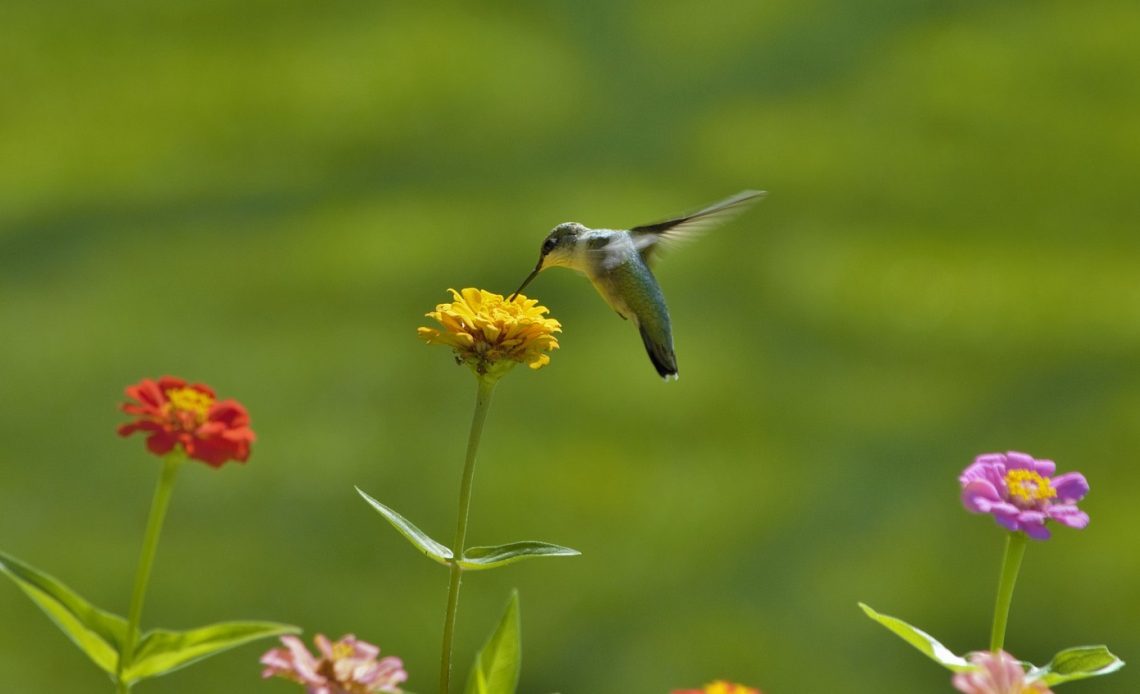

We’re here to help! Wild Yards is a completely free website that is 100% dedicated to helping you create a wildlife-friendly, sustainable yard. Read more
WildYards is reader-supported. When you buy a product through a link on our site, we may earn a comission. Every product is independently selected by our (obsessive) editors and our reviews are unbiased and objective. Read more about our mission or our privacy policy.
Zinnias and hummingbirds seem to be the perfect match – a bright, vibrant flower and a willing pollinator that loves to feed on colorful blooms. That said, do hummingbirds like zinnias?
Hummingbirds love zinnias. In fact, these hardy, heat-loving plants tend to be some of the richest in nectar that you may hope to grow in your own yard. Therefore, if you are hoping to attract more than a few flying pollinators into your garden this coming season, here’s what you need to know about zinnias.
Why do hummingbirds love zinnias?
It’s all about the nectar – zinnias are highly fruitful in the sweet treat, which will naturally attract hummingbirds to the source. Zinnia plants also arrive in a wide, wild variety of species and colors, meaning that the non-discerning hummingbird will likely have plenty to choose from.
You are generally safe to grow most kinds of zinnia and to expect hummingbird visitors. They plant well towards the start of spring and will burst into life come the summer. Most zinnias burn bright in terms of color, meaning you will generally expect shocking pinks, purples, oranges, and reds. That said, their color palette can extend to greens, yellows, and whites, too.
These hummingbird shrubs are classed as annuals when grown between USDA zones two and eight. However, all the way up to zone 11, they can be perennial plants. Hummingbirds native to Mexico will normally flock to zinnias if they can find them. However, they also persist well towards the southern states.
Hummingbirds also love zinnias because they are easy for them to access. They tend to grow up to four feet tall on average, meaning they shouldn’t have to hover too low to the ground to get the nectar they demand.
Gardeners may even find that with zinnias in the garden, there may not always be the need for additional hummingbird food – it’s worth planting these flowers first and then deciding on whether or not to treat them to any extras!
How do I grow zinnias?
Thankfully, zinnias are some of the easiest flowers to grow regardless of your hardiness zone. Even growing them from seeds can be very straightforward. They need access to plenty of sunlight and, of course, regular water. The soil needs to be able to drain well to ensure that roots do not retain moisture, which can lead to diseases and rotting.
Once you have chosen the perfect location for your zinnias, you can start by planting them in rows, leaving a few inches between each of them.
You should plant them around the springtime. Planting them in a frosty or overly wet period could easily lead to the seeds dying. It is best to research the type of zinnias that you plan on cultivating, especially to keep an eye on the height that they might reach. That way, you will be able to decide on where you want to plant them accordingly.
Zinnias are relatively easy flowers to keep, although it is best to keep them watered regularly. Watering and feeding them to about six inches deep will help to sustain them without overstimulating your plants.
Deadheading the zinnias throughout the season will help to ensure that more grow, giving more zinnias in blossom throughout the warmer months.
As zinnias can be annual plants, you will need to replant them every year to ensure that you get a good amount the next year. That is why it is best to keep the seeds from your zinnias every year, ensuring that you get a whole new set for the next growing period.
Are zinnias the best plants to attract hummingbirds with?
Hummingbirds are attracted to many different plants, and it’s normally the promise of nectar that appeals to them. In fact, you may even find hummingbirds attracted by trees such as crepe myrtle. That said, the zinnia is an all-around ‘safe bet’ for bringing hummingbirds into your yard.
Zinnias are great if you are considering splashing a variety of colors and tons of pollen across your yard. They are very easy to propagate and will weather the full sun without much concern. A variety of colors and shades, as well as different types of zinnia, will also help to pique hummingbirds’ interest, as they may be in search of a varied diet.
You’ll also likely find that zinnias attract bees and butterflies, too, thanks to their promise of nectar and attractive colors.
